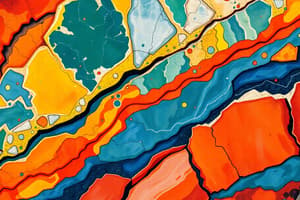Podcast
Questions and Answers
What characterizes igneous rocks with high amounts of silica?
What characterizes igneous rocks with high amounts of silica?
- They usually appear light in color. (correct)
- They are typically dark in color.
- They often have a fine-grained texture.
- They are formed from magma that remains underground.
What defines intrusive igneous rocks?
What defines intrusive igneous rocks?
- They originate from magma that cools beneath the Earth's surface. (correct)
- They are generally fine-grained and dark-colored.
- They cool and crystallize at the Earth's surface.
- They form from lava that erupts from volcanoes.
Which igneous rock is described as light-colored and composed mainly of quartz and feldspar?
Which igneous rock is described as light-colored and composed mainly of quartz and feldspar?
- Obsidian
- Gabbro
- Basalt
- Granite (correct)
Which statement is TRUE regarding obsidian?
Which statement is TRUE regarding obsidian?
What is the main characteristic of basalt as an igneous rock?
What is the main characteristic of basalt as an igneous rock?
How does pumice primarily differ from other igneous rocks?
How does pumice primarily differ from other igneous rocks?
What feature is typical of igneous rocks that indicates their formation?
What feature is typical of igneous rocks that indicates their formation?
Which igneous rock is commonly found in the deep oceanic crust?
Which igneous rock is commonly found in the deep oceanic crust?
What is the primary factor that determines the texture of igneous rocks?
What is the primary factor that determines the texture of igneous rocks?
Which type of igneous rock is formed through rapid cooling of lava above ground?
Which type of igneous rock is formed through rapid cooling of lava above ground?
Which of the following best describes coarse-grained igneous rocks?
Which of the following best describes coarse-grained igneous rocks?
What is the meaning of the term 'extrusive' in relation to igneous rocks?
What is the meaning of the term 'extrusive' in relation to igneous rocks?
What classification of igneous rocks includes large crystals embedded in a groundmass of smaller crystals?
What classification of igneous rocks includes large crystals embedded in a groundmass of smaller crystals?
Which property distinguishes andesite from basalt?
Which property distinguishes andesite from basalt?
Which igneous rock is known for being glassy and having no crystal formation due to rapid cooling?
Which igneous rock is known for being glassy and having no crystal formation due to rapid cooling?
Which of the following statements about igneous rocks is true?
Which of the following statements about igneous rocks is true?
What type of metamorphic rock forms from limestone?
What type of metamorphic rock forms from limestone?
Which of the following is considered a non-foliated metamorphic rock?
Which of the following is considered a non-foliated metamorphic rock?
What is the process called that transforms sedimentary rocks into metamorphic rocks?
What is the process called that transforms sedimentary rocks into metamorphic rocks?
Which rock is formed from sandstone through metamorphism?
Which rock is formed from sandstone through metamorphism?
Anthracite is a type of metamorphic rock that is derived from which original raw material?
Anthracite is a type of metamorphic rock that is derived from which original raw material?
What initiates the rock cycle?
What initiates the rock cycle?
What is the key difference between extrusive and intrusive igneous rocks?
What is the key difference between extrusive and intrusive igneous rocks?
What is the process called that breaks down igneous rocks into sediments?
What is the process called that breaks down igneous rocks into sediments?
What processes are involved in the formation of sedimentary rocks?
What processes are involved in the formation of sedimentary rocks?
Which type of sedimentary rock is formed from the accumulation of organic debris?
Which type of sedimentary rock is formed from the accumulation of organic debris?
Which sedimentary rock is known for containing large, rounded clasts that are greater than two mm in diameter?
Which sedimentary rock is known for containing large, rounded clasts that are greater than two mm in diameter?
How does compaction contribute to the formation of sedimentary rocks?
How does compaction contribute to the formation of sedimentary rocks?
Which of the following is a characteristic of chemical sedimentary rocks?
Which of the following is a characteristic of chemical sedimentary rocks?
What is the main constituent of limestone?
What is the main constituent of limestone?
Which type of sedimentary rock is derived from mechanical weathering?
Which type of sedimentary rock is derived from mechanical weathering?
What primarily distinguishes sandstone from other sedimentary rocks?
What primarily distinguishes sandstone from other sedimentary rocks?
What is the primary characteristic of foliated metamorphic rocks?
What is the primary characteristic of foliated metamorphic rocks?
What type of metamorphism occurs mainly due to contact with magma?
What type of metamorphism occurs mainly due to contact with magma?
Which of the following rocks is formed from the metamorphism of sandstone?
Which of the following rocks is formed from the metamorphism of sandstone?
Which sedimentary rock is known as a valuable source of both petroleum and water?
Which sedimentary rock is known as a valuable source of both petroleum and water?
What is the original rock from which a metamorphic rock is formed called?
What is the original rock from which a metamorphic rock is formed called?
How is gneiss typically characterized in terms of its granules?
How is gneiss typically characterized in terms of its granules?
Which metamorphic rock is derived from shale?
Which metamorphic rock is derived from shale?
Which of the following statements about metamorphic rocks is incorrect?
Which of the following statements about metamorphic rocks is incorrect?
Flashcards are hidden until you start studying
Study Notes
Rocks Overview
- Rocks are solid masses of the lithosphere, composed of one or more minerals and organic matter.
- Petrology is the scientific study of rocks.
- Varied rock properties include color (dark, light, reddish, gray, brown, yellow, black), texture (fine, rough), hardness, and glossiness.
Classification of Rocks
- Three main classifications: igneous, sedimentary, and metamorphic.
Igneous Rocks
- Originates from the Latin "ignis," meaning fire; formed through cooling and crystallization of molten rock (magma).
- Types are categorized based on formation location:
- Extrusive (above ground, cooled quickly): e.g., Basalt, Obsidian, Pumice.
- Intrusive (beneath the ground, cooled slowly): e.g., Granite, Gabbro.
- Texture depends on cooling rates:
- Rapid cooling results in fine-grained rocks.
- Slow cooling results in coarse-grained rocks.
- Classified further into:
- Fine-grained: very small crystals (e.g., rhyolite).
- Coarse-grained: large crystals (e.g., granite).
- Porphyritic: large crystals surrounded by smaller ones.
- Glassy: no crystals, smooth surface (e.g., obsidian).
- Mineral composition distinction:
- Low Silicates: dark-colored rocks.
- High Silicates: light-colored rocks.
Sedimentary Rocks
- Formed through erosion, deposition, compaction, and cementation of sediments.
- Types of sedimentary rocks:
- Clastic: composed of fragments of pre-existing rocks.
- Chemical: formed from mineral precipitation.
- Organic: derived from accumulated organic debris (may contain fossils).
- Examples include Conglomerate (large fragments), Sandstone (sand-size grains), Shale (fine-grained), Limestone (calcium carbonate-rich).
- Significant applications: energy resources (oil, gas), building materials, and historical geology insights.
Metamorphic Rocks
- Arises from the transformation of existing rocks (igneous or sedimentary) under high pressure and temperature.
- Regional metamorphism affects large areas, while contact metamorphism occurs near magma.
- Protolith refers to the original rock before changes.
- Types include:
- Foliated: layered appearance (e.g., Slate, Gneiss).
- Non-foliated: lack of layering (e.g., Marble, Quartzite).
The Rock Cycle
- Begins with molten magma, which solidifies into igneous rock (extrusive or intrusive).
- Weathering breaks down igneous rocks into sediments.
- Sediments are transported and undergo sedimentation, compaction, and cementation.
- Buried sediments transform into metamorphic rocks under heat and pressure.
- Eventually, metamorphic rocks may melt back into magma, continuing the cycle.
- This process has taken place for over 4 billion years, continuously reshaping the Earth.
Studying That Suits You
Use AI to generate personalized quizzes and flashcards to suit your learning preferences.




